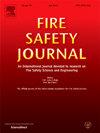Large-scale compartment fires to develop a self-extinction design framework for mass timber-Part 2: Results, analysis and design implications
IF 3.4
3区 工程技术
Q2 ENGINEERING, CIVIL
引用次数: 0
Abstract
This paper seeks to provide key fundamental knowledge underpinning the use of self-extinction principles as part of a design framework for buildings with engineered mass timber structures. The results from six compartment fire experiments in a cross-laminated timber (CLT) enclosure with different ratios of exposed timber are presented and analyzed to establish the effects of timber exposure on the dynamics of a fire and on the potential of the fire to self-extinguish. The results show the relevance of four key parameters that need to be considered concurrently when assessing self-extinction in mass timber compartments: (a) the characteristic time for burnout of the movable fuel load, (b) the characteristic time for the occurrence of char fall-off, (c) the characteristic time for the occurrence of encapsulation failure, and (d) the heat exchange within the compartment after consumption of the moveable fuel. Self-extinction was attained only when the characteristic time for the occurrence of char fall-off was longer than the characteristic time for burn-out and the heat exchange after burn-out resulted in a heat flux below a well-defined threshold. The position of the exposed timber surfaces affected the magnitude of the threshold heat flux. If the characteristic time for burn-out was greater than the characteristic time for encapsulation failure, self-extinction was not observed to occur.
大型隔间火灾开发大量木材的自消设计框架-第2部分:结果,分析和设计含义
本文旨在提供关键的基础知识,支持使用自消原则作为工程木结构建筑设计框架的一部分。本文介绍并分析了在不同暴露比例的交叉层压木材(CLT)围护结构中进行的六室火灾实验结果,以确定木材暴露对火灾动力学和火灾自熄潜力的影响。结果表明,在评估大量木材隔间的自熄灭时,需要同时考虑四个关键参数的相关性:(a)可移动燃料负载燃烬的特征时间,(b)发生炭落的特征时间,(c)发生包封失效的特征时间,以及(d)可移动燃料消耗后隔间内的热交换。只有当炭落发生的特征时间长于燃尽的特征时间,并且燃尽后的热交换导致热流低于定义的阈值时,才能实现自灭。暴露木材表面的位置影响阈值热通量的大小。如果烧坏的特征时间大于封装失效的特征时间,则不会发生自熄现象。
本文章由计算机程序翻译,如有差异,请以英文原文为准。
求助全文
约1分钟内获得全文
求助全文
来源期刊

Fire Safety Journal
工程技术-材料科学:综合
CiteScore
5.70
自引率
9.70%
发文量
153
审稿时长
60 days
期刊介绍:
Fire Safety Journal is the leading publication dealing with all aspects of fire safety engineering. Its scope is purposefully wide, as it is deemed important to encourage papers from all sources within this multidisciplinary subject, thus providing a forum for its further development as a distinct engineering discipline. This is an essential step towards gaining a status equal to that enjoyed by the other engineering disciplines.
 求助内容:
求助内容: 应助结果提醒方式:
应助结果提醒方式:


